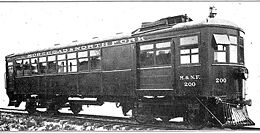
Edwards Rail Car Company
Encyclopedia
Edwards Rail Car Company was located in the small town of Sanford, North Carolina
, specializing in the manufacture of self-propelled rail
cars.

, a short line running from Sanford to Lillington, N.C., was running an uneconomical steam passenger train which A&W General Manager Harry P. Edwards came to regard with mounting frustration. Searching for a way to stem the flow of red ink, Edwards built his first car for use on that railroad. Other cars were built in the shops of the A&W and marketed by Edwards and the Atlantic & Western Railway.
As the word spread throughout the South about the economical rail cars built by Edwards, the demand for cars was such that in 1921 the manufacturing firm Edwards Railway Motor Car Co. was organized and in 1922 occupied its new plant along the tracks of the A&W. The short line was not only an Edwards customer, but its tracks served as a test, demonstration and development track for over twenty years of Edwards car production.
Edwards output during the 1930s was mainly export
cars including the "modern" streamlined Model-21 and the streamlined version of the Model-10, with their distinctive shovel-nose, first developed by Edwards in 1935. By the late 1930s sales of railcars in the United States
was at an all time low, and with the war in Europe, Edwards sold the plant and new owners re-tooled for defense production in 1940.
In 1942 the Edwards Company lost its corporate identity and ceased to exist, rail motor cars and trailers were the only Edwards products manufactured under that name. As of 1933 the company claimed rail car sales to forty-four railroads; final tally of original purchasers was close to fifty. With sales, in a 22-year period to nineteen different countries in the Western Hemisphere
. Only a handful of Edwards cars have survived today.
Sanford, North Carolina
Sanford is a city in Lee County, North Carolina, United States. The population was 23,220 at the 2000 census. It is the county seat of Lee County.-Geography:Sanford is located at ....
, specializing in the manufacture of self-propelled rail
Rail transport
Rail transport is a means of conveyance of passengers and goods by way of wheeled vehicles running on rail tracks. In contrast to road transport, where vehicles merely run on a prepared surface, rail vehicles are also directionally guided by the tracks they run on...
cars.

History
Harry P. Edwards began building passenger railway equipment in 1917 and formed the Edwards Railway Motor Car Company in 1921. Edwards turned out over 130 cars over a two-decade span and made a name for itself among major South and Central American railways, as well as on U.S. Class 1 and short line railroads.Formative years
In 1915 the Atlantic and Western RailwayAtlantic and Western Railway
The Atlantic and Western Railway is a Class III short-line railroad operating about of track in Lee County, North Carolina. Atlantic and Western is part of Genesee & Wyoming Inc. and formerly part of Rail Management and Consulting...
, a short line running from Sanford to Lillington, N.C., was running an uneconomical steam passenger train which A&W General Manager Harry P. Edwards came to regard with mounting frustration. Searching for a way to stem the flow of red ink, Edwards built his first car for use on that railroad. Other cars were built in the shops of the A&W and marketed by Edwards and the Atlantic & Western Railway.
As the word spread throughout the South about the economical rail cars built by Edwards, the demand for cars was such that in 1921 the manufacturing firm Edwards Railway Motor Car Co. was organized and in 1922 occupied its new plant along the tracks of the A&W. The short line was not only an Edwards customer, but its tracks served as a test, demonstration and development track for over twenty years of Edwards car production.
1920–1942
During the early 1920s, mainstays of this output was the Model-10 which had the engine mounted up in the baggage compartment, as was the fashion of most all other manufacturers. In 1926 the company started delivery of the new Model-20. What set the Model-20 apart from the Model-10 and competitor's models was the ingenious, patented, power truck design, with the motor set into the front truck frame instead of being up in the car body.Edwards output during the 1930s was mainly export
Export
The term export is derived from the conceptual meaning as to ship the goods and services out of the port of a country. The seller of such goods and services is referred to as an "exporter" who is based in the country of export whereas the overseas based buyer is referred to as an "importer"...
cars including the "modern" streamlined Model-21 and the streamlined version of the Model-10, with their distinctive shovel-nose, first developed by Edwards in 1935. By the late 1930s sales of railcars in the United States
United States
The United States of America is a federal constitutional republic comprising fifty states and a federal district...
was at an all time low, and with the war in Europe, Edwards sold the plant and new owners re-tooled for defense production in 1940.
In 1942 the Edwards Company lost its corporate identity and ceased to exist, rail motor cars and trailers were the only Edwards products manufactured under that name. As of 1933 the company claimed rail car sales to forty-four railroads; final tally of original purchasers was close to fifty. With sales, in a 22-year period to nineteen different countries in the Western Hemisphere
Western Hemisphere
The Western Hemisphere or western hemisphere is mainly used as a geographical term for the half of the Earth that lies west of the Prime Meridian and east of the Antimeridian , the other half being called the Eastern Hemisphere.In this sense, the western hemisphere consists of the western portions...
. Only a handful of Edwards cars have survived today.

